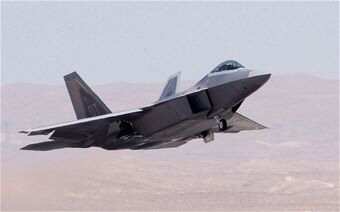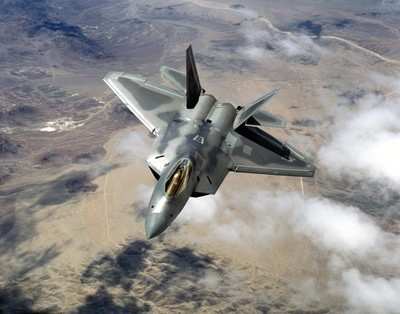Oxygen Generation System Receives The Most Attention In Testimony Thursday
Air Force and NASA leaders testified September 13 before the House Armed Services Committee's Subcommittee on Tactical Air and Land Forces about the F-22 Raptor. Specifically, the leaders testified about the comprehensive studies, findings and actions taken and also underway to address previously unexplained physiological incidents reported by F-22 pilots.

Retired Gen. Gregory S. Martin, Aircraft Oxygen Generation Study chair for the Air Force Scientific Advisory Board; Maj. Gen. Charles W. Lyon, Headquarters Air Combat Command director of operations and F-22 life support task force chair; and Clinton H. Cragg, NASA Engineering and Safety Center principal engineer testified before the subcommittee. "Beginning in 2008 ... the F-22 began to experience a significantly higher rate of hypoxia-like instances with unknown causes as reported by the pilots," said Martin.
That's when the Air Force started an intense search for possible causes of what experts can best describe as physiological incidents and how to fix them. After months of research, testing and analysis, Martin's study group provided eight near-term and three long-term recommendations to the Air Force in September 2011 and completed its investigative actions in January.
The Air Force task force also established in January, and led by Lyon, advanced the SAB's effort and through a multi-service, cross-governmental and functional team, determined that problems with the quantity of oxygen are the major contributors to the previously unexplained incidents. "This is what we've come to know, which the Navy helped us with: ... breathing restrictions integrated into the pilot's flight ensemble forced them to work harder to get the required volumes of air, which can then lead to fatigue symptoms over time," said Lyon.
At the request of Air Force leaders, NASA's engineering and safety center also conducted an independent assessment of the F-22 life support system and the Air Force's efforts and conclusions to ensure all possible causes of the physiological incidents were examined. The center performs independent testing, analysis and assessments for NASA, and assembled a team that included two NASA flight surgeons, two NASA human factor experts, an Environmental Protection Agency forensic chemist, an industry oxygen generator system expert and several specialized NASA life support systems engineers for the F-22 review. "The (NASA Engineering and Safety Center) concurs with the Air Force that the F-22 incidents can be attributed to several factors," said Cragg.

They include restricted breathing due to inappropriate inflation of the upper pressure garment worn by pilots, pressure drops across the oxygen system, and high concentrations of oxygen, the effects of which are compounded during acceleration at lower altitudes. Cragg said his team found no evidence of contaminants in the system. He did note, however, that as in any fighter aircraft, irritant compounds may be present in the cockpit. Additionally, each flight is physiologically demanding and symptoms such as difficulty in breathing during high-G maneuvers and coughing to reinflate the air sacs in the lungs after flight were considered a normal part of flying by the F-22 community. "The acceptance of these phenomena as normal could be seen as a normalization of deviance," said Cragg.
As these studies were ongoing, the Air Force implemented most of the SAB's findings and hasn't had an unexplained physiological incident since March, said Lyon. "Since that time, we've flown more than 10,000 sorties and more than 13,000 hours," said Lyon. "The trend is on a positive vector not seen in years." But he pointed out that there will most likely be some physiological incidents in the future. "The harsh, high-altitude, high-G environment is extremely demanding, and our pilots are aware of those demands," said Lyon. "Just as other Airmen and members of the joint force accept risk in the conduct of their daily military duties, we accept risk in operating the F-22. We encounter physiological incidents in all high-performance aircraft," said Lyon. "The measures taken by the Air Force, in my opinion, will reduce the incident rates significantly and over time bring the F-22 incident rates in-line with comparable high-performance fighter aircraft."
Lyon told the committee the Air Force has completed seven of the eight near-term actions recommended by the SAB, and there is work ahead while the service transitions to normal flight operations. "The path to assuming normal flight operations hinges on the successful development, testing and fielding of a modified combat edge upper pressure garment relief valve," said Lyon. "This modification will successfully integrate the key components in the F-22 life support system to ensure adequate oxygen flows to the pilot while providing protection in high-altitude and high-G environments where the F-22 flies." The modification is expected to be fielded by the end of 2012.

Another modification to the F-22 will add a backup oxygen system in addition to the emergency oxygen system in place. "The fielding of the automatic backup oxygen system will provide additional protection to F-22 pilots while flying in high altitude and in the most demanding oxygen delivery scenarios," said Lyon. The first modified F-22 is expected to be operational in January 2013 with the first operational squadron complete in spring of 2013 and the entire fleet completed by the middle of 2014.
Another initiative recommended by the SAB is a medical registry tracking the long-term effects of flying the F-22 for every pilot, said Martin. Before they were allowed to return to flight in September 2011, every pilot underwent a battery of physiological tests to establish a medical baseline that was entered into the registry. "We know who has flown the F-22. We know who has been exposed to this environment. And we will continue to track them through their Air Force career and, if necessary, beyond," said Lyon. "We have a moral imperative and we understand that."
He said that no long-term health issues have been tied to the F-22, and the Air Force is undertaking numerous improvements to ensure the inherent risk of flying high-performance aircraft is mitigated and the F-22 is used to its full potential. "The F-22 Raptor contributes significantly to our nation's vital interests by providing air dominance when and where ordered to protect and enable the joint U.S. military force," said Lyon. "Flying high-performance fighter aircraft is not risk free. But the risk is measured against mission priorities and probabilities of success."
 SpaceX to Launch Inversion RAY Reentry Vehicle in Fall
SpaceX to Launch Inversion RAY Reentry Vehicle in Fall Aero-News: Quote of the Day (04.23.24)
Aero-News: Quote of the Day (04.23.24) Aero-News: Quote of the Day (04.20.24)
Aero-News: Quote of the Day (04.20.24) ANN's Daily Aero-Linx (04.20.24)
ANN's Daily Aero-Linx (04.20.24) Aero-News: Quote of the Day (04.21.24)
Aero-News: Quote of the Day (04.21.24)





